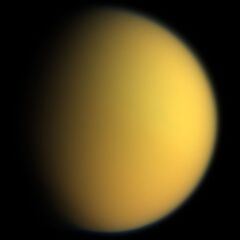
Titan would be a methane planet if it orbited the Sun instead of Saturn
Methane planet is an assumed class of planet with surface covered in lakes or oceans of methane with methane clouds in the atmosphere like it is on Titan, the largest moon of Saturn.
Appearance[]
Viewed from space, methane planet would appear blue to aqua green because methane absorbs red light and reflects blue and green light. Some methane clouds appear white because they contain phosphorus (P) while others are orange because they contain tholin.
Atmosphere and climate[]
Methane planets tend to have similar climates to Earth's, except it uses methane as a "variable gas" instead of water vapor as it is on Earth. For example, there are methane rain or methane snow instead of water rain or water snow. Those planets tend to be frigid, at around −290°F (−179°C). Their atmospheres tend to be composed mostly of nitrogen (N2) and oxygen (O2) with variable amounts of methane (CH4) and trace amounts of nitric oxide (NO) and other gases.
Methane planets tend to be hazy like Titan, because stellar radiation break methane molecules apart and form different hydrocarbons, such as ethane (C2H6), diacetylene (C4H2), methylacetylene (C3H4), acetylene (C2H2) and propane (C3H8). This breakdown can also produce non-hydrocarbons such as carbon dioxide (CO2), carbon monoxide (CO), hydrogen cyanide (HCN), cyanogen ((CN)2), and cyanoacetylene (C3!
Life[]
The life-bearing status on methane planets are fair. Life on methane planets are strange that they can adapt to extreme cold and use methane as a solvent, whereas life on Earth use water as a solvent. Under a hazy atmosphere, the plant life rely on chemosynthesis as there are not enough light for photosynthesis because methane planets orbit far from the light of their parent stars. It is predicted that plants use methane (CH4) and nitric oxide (NO) to produce methanol (CH3OH), nitrogen (N2), and oxygen (O2):
- 2 CH4 + 4 NO + energy → 2 CH3OH + 2 N2 + O2.
It is also predicted that animals take in oxygen and release nitric oxide instead of carbon dioxide. Animals also eat foods rich in methanol and drink liquid methane. The main biogeochemical cycle on methane planet is the methane cycle compared to the carbon cycle here on Earth.
However, life on some methane planets may not be carbon-based but silicon-based as they have better survivability to extreme cold than carbon-based life.
Abundance[]
There are an estimated 43 billion methane planets in our galaxy alone, more than half as abundant as water planets. They make up 10% of all 524 billion terrestrial planets 52‰ of all 820 billion planets in our galaxy.
Related links[]
| ||||||||||||||